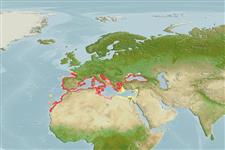Environment: milieu / climate zone / depth range / distribution range
Écologie
marin démersal; profondeur 0 - 120 m (Ref. 122887). Subtropical; 50°N - 10°N, 18°W - 42°E
Eastern Atlantic and Mediterranean Sea: including the Adriatic, Aegean and Black Sea, Portugal and Senegal. Has also been reported from southern Morocco, Mauritania, and Angola (Ref. 10813).
Taille / Poids / Âge
Maturity: Lm ? range ? - ? cm
Max length : 17.0 cm TL mâle / non sexé; (Ref. 3397); common length : 12.5 cm TL mâle / non sexé; (Ref. 3397)
Description synthétique
Clés d'identification | Morphologie | Morphométrie
Épines dorsales (Total) : 0; Rayons mous dorsaux (Total) : 53 - 59; Rayons mous anaux: 27 - 32; Vertèbres: 64 - 68. Ventrolateral skin-folds extending well beyond pectoral fins to anus. Lateral line branched. Back golden brown or greenish, belly silvery, head usually dark blue.
Found over shell-gravel and coarse sand bottoms (Ref. 6450). Minimum depth from Ref. 122877.
Life cycle and mating behavior
Maturité | Reproduction | Frai | Œufs | Fécondité | Larves
Quéro, J.-C., 1990. Ammodytidae. p. 920. In J. C. Quéro, J. C. Hureau, C. Karrer, A. Post and L. Saldanha (eds.) Check-list of the fishes of the eastern tropical Atlantic (CLOFETA). JNICT, Lisbon; SEI, Paris; and UNESCO, Paris. Vol. 2. (Ref. 10813)
Statut dans la liste rouge de l'IUCN (Ref. 130435: Version 2024-1)
Menace pour l'homme
Harmless
Utilisations par l'homme
Pêcheries: commercial
Outils
Articles particuliers
Télécharger en XML
Sources Internet
Estimates based on models
Preferred temperature (Ref.
123201): 7.8 - 18.1, mean 14.3 °C (based on 57 cells).
Phylogenetic diversity index (Ref.
82804): PD
50 = 0.6250 [Uniqueness, from 0.5 = low to 2.0 = high].
Bayesian length-weight: a=0.00102 (0.00046 - 0.00225), b=3.06 (2.88 - 3.24), in cm total length, based on all LWR estimates for this body shape (Ref.
93245).
Niveau trophique (Ref.
69278): 3.4 ±0.45 se; based on food items.
Résilience (Ref.
120179): Haut, temps minimum de doublement de population inférieur à 15 mois (Preliminary K or Fecundity.).
Fishing Vulnerability (Ref.
59153): Low vulnerability (10 of 100).
Nutrients (Ref.
124155): Calcium = 164 [94, 345] mg/100g; Iron = 1.41 [0.85, 2.56] mg/100g; Protein = 18.6 [16.8, 20.5] %; Omega3 = 0.267 [0.154, 0.459] g/100g; Selenium = 25.7 [12.4, 53.8] μg/100g; VitaminA = 26.8 [8.7, 82.0] μg/100g; Zinc = 0.969 [0.664, 1.406] mg/100g (wet weight);
